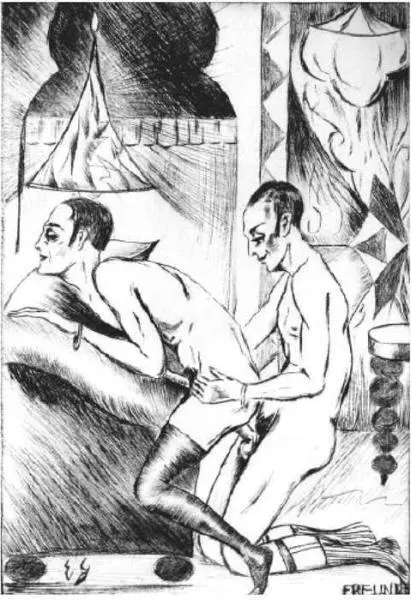
Ernst Gerhard, Friends , 1925
Interestingly, the psychoanalytic and related psychogenetic theories—largely because of their straight and Jewish associations—were ignored by Berlin’s queers, who appeared content with their orientation. Only anxious bisexual men and fellow social scientists showed obvious interest.

Hildebrand, The Dinner
Homosexual Life in Weimar Berlin
The idyllic gay portrait of dapper German Army officers in capes and peaked caps transfixed by demure Line-Boys on the Tiergarten benches disappeared from view in 1919. It was beggars who retained the combat dress of the defeated army. Berlin’s gay community at the beginning of Weimar adopted a different wardrobe, the sailor’s blouse and cap (alongside the tailored morning-coat of the perfumed dandy). In homosexual Dielen , middle-aged Sugar-Lickers , Coolies , Doll-Boys , even crotchety waiters wore the crisp blue-and-white insignia of jaunty marines on shore leave. The change of uniform had various meanings. Partly, it was matter of identification—straights didn’t wear them—and they were a Wilhelmian echo of adolescent androgyny. More significantly, Berlin’s core homosexual community had expended far beyond the units of the Potsdam garrison.
In 1922, one of Berlin’s police commissioners estimated the total number of gay men to be in excess of 100,000 and teenage male prostitutes (whom he did not consider to be truly queer) around 25,000. Over the next eight years, the numbers of resident queers sky-rocketed. Partly because of more sophisticated polling methods and real growth, the homosexual populace was determined to be over 350,000 by 1930.
Unlike Berlin’s lesbians, the gay community was noticeably invisible during daytime hours. At various times, homosexual men supported a gay-themed playhouse, “The Theatre of Eros,” a bowling league, stamp-collecting society, poetry readings, and a handful of other artistic enterprises, but mostly closed-door, nighttime venues, like winter-balls, cabarets, dance halls and Dielen were their traditional haunts. Berlin queers lacked a resolute sense of political and social cohesion, despite the intensive efforts by the Homosexualist and Third-Sex organizers. (Probably less than ten percent belonged to all-male clubs.) Fear of public exposure and unadorned hedonistic concerns guided the majority of deviant lifestyles.
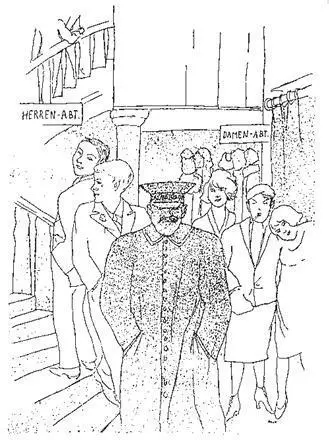
Hildebrand, On the Town
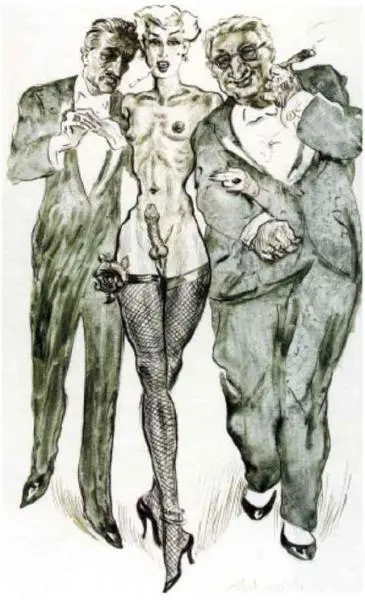
Schad, Zauberflote , 1930
A former Line-Boy , only identified as “Erich” in an interview conducted in 1978 (and later transcribed in Gay Voices from East Germany ), recalled the closeted, if exhilarating, times:
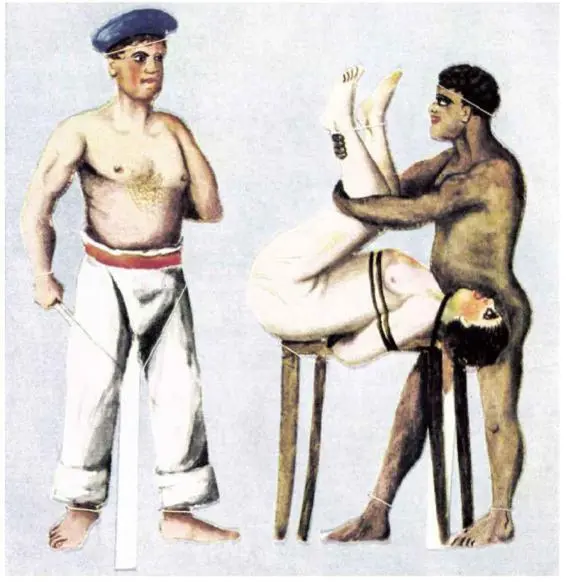
Amateur fantasy drawing
In the Twenties there was scarcely an occupational group that was not represented at the famous drag balls in the big Berlin ballrooms. We “simple lads” came dressed as Asta Nielsen or Henny Porten [European film stars] and let ourselves be served champagne by coarse, cursing taxi drivers or man-servants. It was part of the craziness of the setting that these tough servants and taxi drivers exchanged their gear next morning for the judge’s robe or the doctor’s white coat. It even happened that an “Asta” would be sent to the clink for shoplifting a week later by her “manservant.”
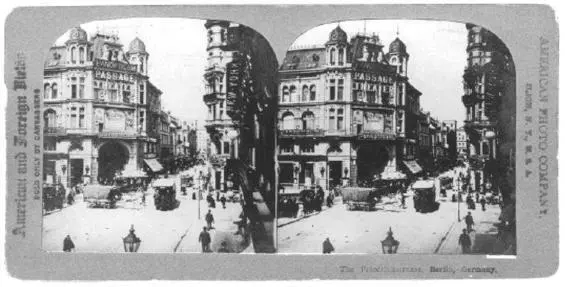
The Linden-Passage at Friedrichstrasse corner
Erich likened Weimar to a mad carousel ride, where centrifugal forces blew some youthful participants into the gutter, while other teenage daredevils leaped on the treacherous merry-go-round to replace them.
Still, the sexcapades of homosexuals more than rivaled the piquant Bummels of the het Girl-Culture. For some straight Berliners, queer promiscuity and sexual bravado was a cause for envy and erotic introspection. Curt Riess captured this covetous relationship sardonically in his Berlin memoirs. Two distinguished-looking men at a table in the Nachtlokal “Schwannecke”:
Walter Steinthal(editor of the 12-Uhr Blatt and a famous womanizer): “I could see myself fucking a boy. But he’d have to be young. Fourteen or fifteen.”
Hans Heinrich von Twardowsky(a flamboyant gay actor): “Why not?”
Steinthal:“He would have to be a natural blonde.”
Von Twardowsky:“Why not?”
Steinthal:“And he couldn’t have too much hair on his body.”
Von Twardowsky(staring at Steinthal in icy disgust before making a fast exit): “Goddamnit, man, you might as well fuck a woman!”
Wandervogel and the Wild-Boys
Implied and overt forms of male homosexuality, of course, had other public outlets in Berlin. The military, the elite Gymnasiums and academies, the Life Reform (or Nacktkultur ) movement were all embroiled in florid accusations of male pederasty and sex scandal throughout the Wilhelmian era. But one mass association in particular was thought to be rife with man-boy love: the unique German Youth Movement known as the Wandervogel (“Wandering Bird”).
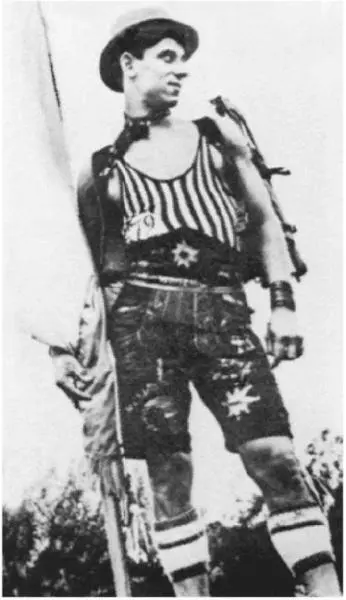
Winnetou, Wild-Boy Chieftain of the Wild and Free gang, 1932
Although it resembled the Anglo-Saxon Boy Scouts in popularity and appearance, the Wandervogel , astonishingly, evolved in a strange Pied Piper fashion. This was an overnight phenomenon, created by male teens for male teens. Its institutional founding took place in the Berlin suburb of Steglitz in 1896 and grew exponentially across the nation for the next 35 years.
A product of Pan-German and Naturalist sentiments, the Wandervogels proselytized a Romantic back-to-nature doctrine, railing against deleterious urban lifestyles and the consumption of alcohol and meat. Forty-kilometer hikes over mountainous paths, the robust singing of German folk ballads, countryside overnights, and frolicking male camaraderie were the signature activities of the Wandervogel. Curiously, the steadfast movement eschewed politics. But its appeal just before the Great War struck a deep patriotic chord. Nationalist, Catholic, and Socialist leaders fielded their own Wandervogels with separate flags, anthems, and uniforms. Five years into the Weimar period, Nazi, Red Front, and German Zionist organizations also created corresponding versions of bronzed warrior-youths, marching in place. These ideologically opposed squadrons of husky German teenagers often crossed paths in desolate terrains and pitched camp within bonfire sight of one another.
Читать дальше



















